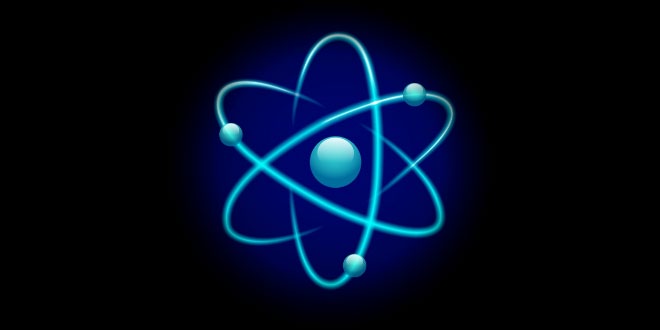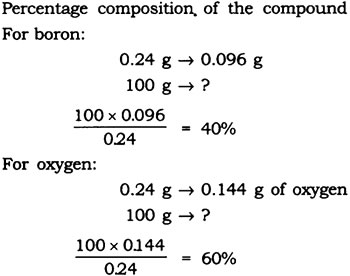Question: A 0.24 g sample of compound of oxygen and boron was found by analysis to contain 0.096 g of boron and 0.144 g of oxygen. Calculate the percentage composition of the compound by weight.
Answer: Boron and oxygen compound —> Boron + Oxygen
0.24 g —> 0.096 g + 0.144 g
Question: When 3.0 g of carbon is burnt in 8.00 g oxygen, 11.00 g of carbon dioxide is produced. What mass of carbon dioxide will be formed when 3.00 g of carbon is burnt in 50.00 g of oxygen? Which law of chemical combination will govern your answer?
Answer: The reaction of burning of carbon in oxygen may be written as:
It shows that 12 g of carbon bums in 32 g oxygen to form 44 g of carbon dioxide. Therefore 3 g of carbon reacts with 8 g of oxygen to form 11 g of carbon dioxide. It is given that 3.0 g of carbon is burnt with 8 g of oxygen to produce 11.0 g of CO2. Consequently 11.0 g of carbon dioxide will be formed when 3.0 g of C is burnt in 50 g of oxygen consuming 8 g of oxygen, leaving behind 50 – 8 = 42 g of O2. The answer governs the law of constant proportion.
Question: What are poly atomic ions? Give examples.
Answer: The ions which contain more than one atoms (same kind or may be of different kind) and behave as a single unit are called polyatomic ions e.g., OH–, SO42-, CO32-.
Question: Write the chemical formulae of the following:
(1) Magnesium chloride
(2) Calcium oxide
(3) Copper nitrate
(4) Aluminium chloride
(5) Calcium carbonate.
Answer:
- Magnesium chloride
Symbol —> Mg Cl
Change —> +2 -1
Formula —> MgCl2 - Calcium oxide
Symbol —> Ca O
Charge —> +2 -2
Formula —> CaO - Copper nitrate
Symbol —> Cu NO
Change +2 -1
Formula -4 CU(N03)2 - Aluminium chloride
Symbol —> Al Cl
Change —> +3 -1
Formula —> AlCl3 - Calcium carbonate
Symbol —> Ca CO3
Change —> +2 -2
Formula —> CaC03
Question: Give the names of the elements present in the following compounds:
(1) Quick lime
(2) Hydrogen bromide
(3) Baking powder
(4) Potassium sulphate.
Answer:
- Quick lime —> Calcium oxide
Elements —> Calcium and oxygen - Hydrogen bromide
Elements —> Hydrogen and bromine - Baking powder —> Sodium hydrogen carbonate
Elements —> Sodium, hydrogen, carbon and oxygen - Potassium sulphate
Elements —> Potassium, sulphur and oxygen
Question: Calculate the molar mass of the following substances.
(1) Ethyne, C2H2
(2) Sulphur molecule, S8
(3) Phosphorus molecule, P4 (Atomic mass of phosphorus = 31)
(4) Hydrochloric acid, HCl
(5) Nitric acid, HNO3
Answer: The molar mass of the following: [Unit is ‘g’]
- Ethyne, C2H2 = 2 x 12 + 2 x 1 = 24 + 2 = 26 g
- Sulphur molecule, S8 = 8 x 32 = 256 g
- Phosphorus molecule, P4=4 x 31 = i24g
- Hydrochloric acid, HCl = 1 x 1 + 1 x 35.5 = 1 + 35.5 = 36.5 g
- Nitric acid, HN03 = 1 x 1 + 1 x 14 + 3 x 16 = 1 + 14 + 48 = 63 g
Question: What is the mass of
- 1 mole of nitrogen atoms?
- 4 moles of aluminium atoms (Atomic mass of aluminium = 27)?
- 10 moles of sodium sulphite (Na2S03)?
Answer:
- Mass of 1 mole of nitrogen atoms = 14 g
- 4 moles of aluminium atoms
Mass of 1 mole of aluminium atoms = 27 g
∴ Mass of 4 moles of aluminium atoms = 27 x 4 = 108 g - 10 moles of sodium sulphite (Na2SO3)
Mass of 1 mole of Na2SO3 = 2 x 23 + 32 + 3 x 16 = 46 + 32 + 48 = 126 g
∴ Mass of 10 moles of Na2SO3 = 126 x 10 = 1260 g
Question: Convert into mole.
- 12 g of oxygen gas
- 20 g of water
- 22 g of Carbon dioxide.
Answer:
- Given mass of oxygen gas = 12 g
Molar mass of oxygen gas (O2) = 32 g
Mole of oxygen gas 12/32 = 0.375 mole - Given mass of water = 20 g
Molar mass of water (H2O) = (2 x 1) + 16 = 18 g
Mole of water = 20/18 = 1.12 mole - Given mass of Carbon dioxide = 22 g
Molar mass of carbon dioxide (CO2) = (1 x 12) + (2 x 16)
= 12 + 32 = 44 g
∴ Mole of carbon dioxide = 22/44 = 0.5 mole
 Class Notes NCERT Solutions for CBSE Students
Class Notes NCERT Solutions for CBSE Students




